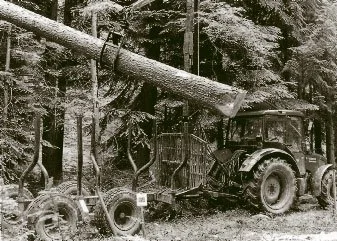Former head forester Phil Hutt
A combination of copper and arsenic sounds a lethal botanical cocktail. However, an area near Tavistock on the borders of Devon and Cornwall, extensively mined for copper - the Victorian mines of Devon Great Consols were, in the 1860s, the world’s largest - and then arsenic, is the unlikely setting for a silvicultural experiment which, over the past four decades, has established itself as an exemplar of continuous cover, irregular-managed forest.
The original concept arose from the 6th Earl of Bradford, an enthusiastic forester, who realised the importance of soil protection; indeed he was Chairman of the Soil Association. Armed with a good deal of practical experience with mixed crops and nurse species from Weston Park, his Shropshire Estate, he bought the 140 hectare woodland in 1959, with its mineshafts and its sawmill, to add to his active forestry interests.
His objective was to develop a commercial forest which protected the sometimes very steep Devon valleys from erosion by avoiding clearfelling, had an attractive and diverse appearance, and yet was able to take advantage of the potentially very high growth rates achievable by exotic conifers in the warm South West of England.
These favourable growing conditions and an active imagination were not the Earl’s only advantages. He needed to turn his concept into a workable system, and here he looked to the remarkable Phillip Hutt, his head forester. Together they evolved the formalised selection forest which has become known as the Bradford Hutt Plan.
This set out to treat uniform plantations of even-aged larch and pine to irregular stands over a period of some 50 years, the time required to produce 41 sawlogs of a size and quality best fitted to local milling capacity.
Viscount Newport, Lord Bradford, forestry manager Mark Snellgrove and retired head forester Phil Hutt with the last tree to be felled under the Bradford Hutt plan are pictured with other guests including WH Trustee Steele Haughton and Esmond Harris (extreme left) who gathered to join in the celebration.
The forest was divided up into 18m square units (each comprising nine plots and each divided from its neighbour by a timber extraction rack leading to a forest road) around which felling of the existing crop, re-planting, thinning and ultimate final felling progressed in a logical sequence.
Once established, every six years, one 54-year-old tree is harvested from a unit and the other plots thinned as necessary. The bare plot created by felling is then replanted.
The result is a forest which looks initially pretty random. After a while, the geometry of the plots begins to reveal itself. The overall effect is an open canopy, with a good deal of light falling to the forest floor. This produces a pleasing, diverse, uneven-aged appearance. That such an apparently complex system can have survived and prospered, initially in the face of considerable opposition from the forestry establishment, says a lot for the original concept, and for the skill and persistence of the woodland staff.
The final tree, having been felled, is removed.Viscount Newport, Lord Bradford's son, plants a Douglas Fir
One of the principal ingredients has been the continuity of enthusiasm within the Bradford family. When the 6th Earl died in 1981, the present Lord Bradford carried the scheme forward. This had several unforeseen difficulties, not least was its unsuitability for the favourable Schedule D/Schedule B tax regime that sustained the private sector in the eighties.
Years of wrangling with the Inland Revenue finally produced a workable compromise, just in time for the 1988 Budget abolishing Schedule D!
A second problem was the shade-bearing conifers around which the system was based. Western Hemlock (Tsuga heterophylla) and the Western Red Cedar (Thuja plicata) were very much the flavour of the times in the fifties and sixties, but by the nineties both had fallen from favour, for poor timber quality, and for their unfortunate habit of regenerating far too freely.
The heavy crowns of the Hemlock also tended to take up too much room in the plots, and Douglas fir is now steadily replacing both in current new plantings.
Lord Bradford, speaking in early June at an informal celebration of the felling and replanting of the last plot, Coupe 9 of the original Bradford Hutt plan, paid tribute to the imagination of the plan’s progenitors. His audience included the staff and Trustees of the Tavistock Woodlands Estate, their contractors, and friends, of course including the long retired Phillip Hutt, who took advantage of a warm morning to arrive at the age of 90, on a smart BMW motorcycle.
To commemorate the event, Mark Snellgrove, woodland manager of the Tavistock Woodland Estate, presented Lord Bradford with a beautifully turned bowl made from Nothofagus timber, an apt choice as the UK’s national collection of Nothofagus, some 30-plus species, forms part of the Tavistock Woodlands.
Can the Bradford Hutt plan survive in an age of low returns and the ascendancy of public benefit as a management priority? It would be sad if such a large-scale and long term system were to be prejudiced by continuing marketing problems, but there is comfort in the happy appearance of the woods and the determination of the owners, their advisors and staff to see that it continues.
We are indebted to Forestry and British Timber Magazine for permission to reproduce this article.




